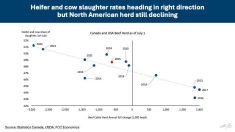The U.S. House of Representatives has passed and sent to President Barack Obama a bill that boosts funding for the school lunch program by $4.5 billion through 2020 and bans “junk” food from school buildings.
Backers said it would be the first real increase in reimbursement rates for schools in 30 years and a step toward healthier meals. Obama is expected to sign the bill, which the Senate passed in August.
When he took office, Obama suggested an increase of $1 billion a year as part of a campaign to end childhood hunger by 2015. Congress postponed work for a year because of funding shortages. In the end, it scaled back a recession-fighting increase in food stamp benefits to pay for the bill.
Read Also

Hunting with whiskey jacks
Canada jays, or whiskey jacks, are bold little deer hunting pals that don’t mind getting close, if it means a piece of the offal or deer fat left over from a successful forest hunt in Manitoba.
More than 32 million students eat hot meals each day through the school lunch program and more than 12 million a day eat breakfast through a companion program. Two-thirds of the lunches are free or at reduced price for poor children.
The government underwr ites school meals, operated by local schools, and a handful of smaller child-nutrition programs at more than $17 billion a year. The bill approved by Congress would increase funding by $450 million annually for a decade.
It would add about 115,000 students to the program by streamlining paperwork and allow universal access at schools in high-poverty areas.
It boosts the per-meal reimbursement by six cents, the first noninflationary increase in 30 years, and bans high-calorie sugary and salty “junk” foods. It also would help pay for after-school meals to poor children at child-care centres.
First Lady Michelle Obama said in a statement the bill “will significantly improve the quality of meals that children receive at school and will play an integral role in our efforts to combat childhood obesity.”














